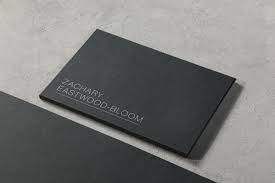In the world of business networking, a business card remains one of the most effective tools for establishing a professional identity. Whether you’re attending a networking event, meeting a potential client, or exchanging information with a colleague, your business card serves as a tangible representation of who you are and what you do. Among the many formats available for business cards, the 90×54 mm size is particularly popular in China and several other Asian countries. But why is this size so prevalent, and how can it impact the way you present your business?
In this article, we will explore the significance of the 90×54 China business card, its design aspects, and tips for ensuring that your card stands out in a crowded professional landscape.
What is the 90×54 China Business Card?
The 90×54 mm business card refers to a specific size commonly used in China and various parts of East Asia. This card is slightly smaller than the typical Western business card, which is usually 3.5 x 2 inches (about 88.9 x 50.8 mm). While the size difference may seem marginal, it plays a role in how business cards are perceived and handled in different cultures.
The 90×54 mm size is more compact than its Western counterpart, which makes it easier to carry and fit into smaller pockets or wallets. The slight difference in size may seem like a minor detail, but in the world of business cards, every aspect of the design—down to the size—can influence how your card is received.
The Cultural Importance of Business Cards in China
In China, the exchange of business cards holds significant cultural value. It’s more than just a way of sharing contact information; it’s an important part of the formal introduction process, and the way you present your card can speak volumes about your respect for the other person and your professionalism. In fact, giving and receiving business cards is often accompanied by a few important rituals, such as holding the card with both hands when giving it and taking a moment to carefully inspect the card before putting it away.
For businesses and professionals who engage in China-related business activities or are looking to network in Chinese markets, understanding these cultural nuances is essential. Here’s why the 90×54 China business card holds such importance:
- Respect and Tradition: In China, business card exchanges are deeply rooted in respect. Offering your card with both hands is seen as a sign of courtesy and professionalism. The size of the card, as well as its design, can reflect your attention to detail and your understanding of local business customs.
- Cultural Sensitivity: If you’re operating in China or engaging with Chinese clients, using a 90×54 card can show that you are attuned to local business practices. While Western businesses often opt for a standard-sized card, adopting the local size indicates cultural sensitivity and an understanding of the professional environment.
- First Impressions Matter: A business card in China is often the first point of contact between two individuals, and as such, it plays a critical role in forming a lasting first impression. A high-quality, well-designed card that fits neatly into a Chinese wallet or cardholder can enhance your reputation and set the tone for a positive relationship.
The Design of a 90×54 China Business Card
When designing a 90×54 business card, it’s essential to consider both the visual appeal and the functionality of the card. While the design should be professional, it also needs to stand out and make a memorable impression.
Here are several design tips to ensure that your 90×54 business card leaves a positive impact:
1. Minimalist Design
A cluttered business card can be overwhelming, especially when dealing with the compact size of a 90×54 card. Instead, focus on creating a minimalist design that includes only essential information. This might include:
- Your name
- Job title
- Company name
- Contact details (phone number, email, website, and social media profiles)
- Company logo
Keep the fonts simple and legible, and avoid using too many colors or design elements that might distract from the core message.
2. Dual-Sided Printing
Due to the limited space on a 90×54 business card, consider using both sides of the card. The front side can contain your primary contact information, while the back can be used for additional details, such as:
- A brief company description
- A QR code that leads to your website or portfolio
- A personal tagline or mission statement
- A map or directions to your office (if applicable)
Dual-sided printing allows you to make the most out of the limited space while ensuring that all necessary details are included without overcrowding the card.
3. Use of Colors and Logos
Colors can have a powerful impact on the perception of your business card. In China, certain colors carry specific meanings, so it’s important to choose your palette carefully. For example:
- Red: A color associated with good luck, prosperity, and celebration in Chinese culture.
- Gold: Represents wealth and success.
- Black: A symbol of power and sophistication.
Your logo should be prominent and clearly visible, especially if it’s central to your brand identity. Make sure it’s crisp, high-quality, and visually aligned with your company’s message.
4. Typography and Fonts
The choice of font can also make a significant difference in the effectiveness of your business card. Opt for professional fonts that are easy to read, especially in small sizes. Avoid overly decorative or fancy fonts that may appear unprofessional or difficult to read. In China, it’s also advisable to include both English and Chinese versions of your name and contact information, if possible. This shows that you’re not only respectful of the local culture but also willing to make it easier for Chinese clients to communicate with you.
5. Material and Finish
The material and finish of your business card can set it apart from others. Opt for high-quality card stock that feels durable and substantial to the touch. Matte finishes are often preferred for a sleek, modern look, while glossy finishes can make colors pop and create a more vibrant visual appeal.
Best Practices for Exchanging Business Cards in China
Knowing how to exchange your business card properly is just as important as the card’s design. Here are some important tips to keep in mind when you hand over your 90×54 business card in China:
- Present the Card with Both Hands: This shows respect to the person receiving it.
- Take a Moment to Inspect the Card: When receiving a business card, it’s courteous to take a moment to carefully examine it before putting it away. This gesture demonstrates that you value the person and their information.
- Avoid Putting the Card Away Immediately: Don’t just shove the card into your pocket or wallet. Place it respectfully on the table or in a business card holder.
- Use Quality Business Card Holders: When storing your cards, use a professional cardholder to keep them neat and undamaged.
Conclusion
The 90×54 China business card is much more than just a practical tool for sharing your contact information. It represents your professional image, reflects your cultural sensitivity, and plays an important role in the business world in China and other parts of East Asia. By paying attention to the design, presentation, and etiquette surrounding your business card, you can make a lasting impression and foster stronger business relationships.
Whether you’re designing your first business card or looking to update an existing one, understanding the significance of the 90×54 card size will help you navigate the Chinese business environment with confidence.



